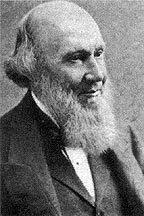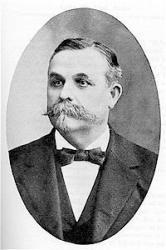Planning worship?
Check out our sister site, ZeteoSearch.org,
for 20+ additional resources related to your search.
- |
User Links
Search Results
O, What a Savior, That He Died for Me
Author: James McGranahan Meter: 10.10.10.6 with refrain Appears in 50 hymnals First Line: O, what a Savior, that He died for me! Refrain First Line: Verily, verily, I say unto you Lyrics: 1 O, what a Savior, that He died for me!
From condemnation He hath made me free;
"He that believeth on the Son," saith He,
"Hath everlasting life."
Refrain:
"Verily, verily, I say unto you,
Verily, verily," message ever new;
"He that believeth on the Son," 'tis true,
"Hath everlasting life."
2 All my iniquities on Him were laid,
All my indebtedness by Him was paid;
All who believe on Him, the Lord hath said,
"Hath everlasting life." (Refrain)
3 Though poor and needy I can trust my Lord,
Though weak and sinful I believe His Word;
O, glad message! every child of God
"Hath everlasting life." (Refrain)
4 Though all unworthy, yet I will not doubt,
For him that cometh, He will not cast out;
"He that believeth," O the good news shout,
"Hath everlasting life." (Refrain) Topics: Christ Savior; Testimony, Hymns of; Witness, Hymns of Scripture: Isaiah 53:6 Used With Tune: VERILY
O, What a Savior, That He Died for Me
And didst Thou love the race that loved not Thee?
Author: Jean Ingelow, 1820-97 Meter: 10.10.10.6 with refrain Appears in 26 hymnals Topics: The Lord Jesus Christ His Life, Teaching, and Example Used With Tune: ARTAVIA
And didst Thou love the race that loved not Thee?
Jesus, Wonderful Lord!
Author: Paul White, 20th c. Meter: 10.10.10.6 with refrain Appears in 13 hymnals First Line: Born among cattle, in poverty sore Refrain First Line: Wonderful, wonderful Jesus! Topics: Epiphany Used With Tune: JESUS, WONDERFUL LORD
Jesus, Wonderful Lord!
I Sought the Lord, and Afterward I Knew
Author: Unknown Hymnal: Hymnbook for Christian Worship #11 (1970) Meter: 10.10.10.6 with refrain Topics: His Love Languages: English Tune Title: PEACE
I Sought the Lord, and Afterward I Knew
Jesus, Wonderful Lord!
Author: Paul White, 20th c. Hymnal: Ambassador Hymnal #60 (1994) Meter: 10.10.10.6 with refrain First Line: Born among cattle, in poverty sore Refrain First Line: Wonderful, wonderful Jesus! Topics: Epiphany Languages: English Tune Title: JESUS, WONDERFUL LORD
Jesus, Wonderful Lord!
And didst Thou love the race that loved not Thee?
Author: Jean Ingelow, 1820-97 Hymnal: The Methodist Hymn-Book with Tunes #149 (1933) Meter: 10.10.10.6 with refrain Topics: The Lord Jesus Christ His Life, Teaching, and Example Languages: English Tune Title: ARTAVIA
And didst Thou love the race that loved not Thee?
Anonymous
Meter: 10.10.10.6 with refrain Author of "I Sought the Lord, and Afterward I Knew" in Trinity Hymnal (Rev. ed.) In some hymnals, the editors noted that a hymn's author is unknown to them, and so this artificial "person" entry is used to reflect that fact. Obviously, the hymns attributed to "Author Unknown" "Unknown" or "Anonymous" could have been written by many people over a span of many centuries.
Anonymous
E. J. Hopkins

1818 - 1901 Person Name: Edward J. Hopkins Meter: 10.10.10.6 with refrain Composer of "ARTAVIA" in The Hymnal Dr Edward John Hopkins MusDoc United Kingdom 1818-1901. Born at Westminster, England, the son of a clarinetist with the Royal Opera House orchestra, he became an organist (as did two of his brothers) and a composer. In 1826 he became a chorister of the Chapel Royal and sang at the coronation of King William IV in Westminster Abbey. He also sang in the choir of St. Paul’s Cathedral, a double schedule requiring skill and dexterity. On Sunday evenings he would play the outgoing voluntary at St. Martin’s in-the-field. He left Chapel Royal in 1834 and started studying organ construction at two organ factories. He took an appointment at Mitcham Church as organist at age 16, winning an audition against other organists. Four years later he became organist at the Church of St. Peter, Islington. In 1841 he became organist at St. Luke’s, Berwick St., Soho. Two Years later he was organist at Temple Church, which had a historic organ (built in 1683). He held this position for 55 years. In 1845 he married Sarah Lovett, and they had four sons and five daughters. He was closely associated with the Bach Society and was organist for the first English performances of Bach’s St. Matthew Passion. In 1855 he collaborated with Edward Rimbault publishing “The organ, its history and construction” (3 editions 1855-70-77). In 1864 he was one of the founders of the “College of organists”. In 1882 he received an honorary Doctorate of Music from the Archbishop of Canterbury. He composed 30+ hymn tunes and some psalm chants, used by the Church of England. He died in London, England.
John Perry
E. J. Hopkins
James McGranahan

1840 - 1907 Meter: 10.10.10.6 with refrain Author of "O, What a Savior, That He Died for Me" in Hymns for the Living Church James McGranahan USA 1840-1907. Born at West Fallowfield, PA, uncle of Hugh McGranahan, and son of a farmer, he farmed during boyhood. Due to his love of music his father let him attend singing school, where he learned to play the bass viol. At age 19 he organized his first singing class and soon became a popular teacher in his area of the state. He became a noted musician and hymns composer. His father was reluctant to let him pursue this career, but he soon made enough money doing it that he was able to hire a replacement farmhand to help his father while he studied music. His father, a wise man, soon realized how his son was being used by God to win souls through his music. He entered the Normal Music School at Genesco, NY, under William B Bradbury in 1861-62. He met Miss Addie Vickery there. They married in 1863, and were very close to each other their whole marriage, but had no children. She was also a musician and hymnwriter in her own right. For a time he held a postmaster’s job in Rome, PA. In 1875 he worked for three years as a teacher and director at Dr. Root’s Normal Music Institute. He because well-known and successful as a result, and his work attracted much attention. He had a rare tenor voice, and was told he should train for the operatic stage. It was a dazzling prospect, but his friend, Philip Bliss, who had given his wondrous voice to the service of song for Christ for more than a decade, urged him to do the same. Preparing to go on a Christmas vacation with his wife, Bliss wrote McGranahan a letter about it, which McGranahan discussed with his friend Major Whittle. Those two met in person for the first time at Ashtubula, OH, both trying to retrieve the bodies of the Bliss’s, who died in a bridge-failed train wreck. Whittle thought upon meeting McGranahan, that here is the man Bliss has chosen to replace him in evangelism. The men returned to Chicago together and prayed about the matter. McGranahan gave up his post office job and the world gained a sweet gospel singer/composer as a result. McGranahan and his wife, and Major Whittle worked together for 11 years evangelizing in the U.S., Great Britain, and Ireland. They made two visits to the United Kingdom, in 1880 and 1883, the latter associated with Dwight Moody and Ira Sankey evangelistic work. McGranahan pioneered use of the male choir in gospel song. While holding meetings in Worcester, MA, he found himself with a choir of only male voices. Resourcefully, he quickly adapted the music to those voices and continued with the meetings. The music was powerful and started what is known as male choir and quartet music. Music he published included: “The choice”, “Harvest of song”, “Gospel Choir”,, “Gospel hymns #3,#4, #5, #6” (with Sankey and Stebbins), “Songs of the gospel”, and “Male chorus book”. The latter three were issued in England. In 1887 McGranahan’s health compelled him to give up active work in evangelism. He then built a beautiful home, Maplehurst, among friends at Kinsman, OH, and settled down to the composition of music, which would become an extension of his evangelistic work. Though his health limited his hours, of productivity, some of his best hymns were written during these days. McGranahan was a most lovable, gentle, modest, unassuming, gentleman, and a refined and cultured Christian. He loved good fellowship, and often treated guests to the most delightful social feast. He died of diabetes at Kinsman, OH, and went home to be with his Savior.
John Perry
James McGranahan


 My Starred Hymns
My Starred Hymns

